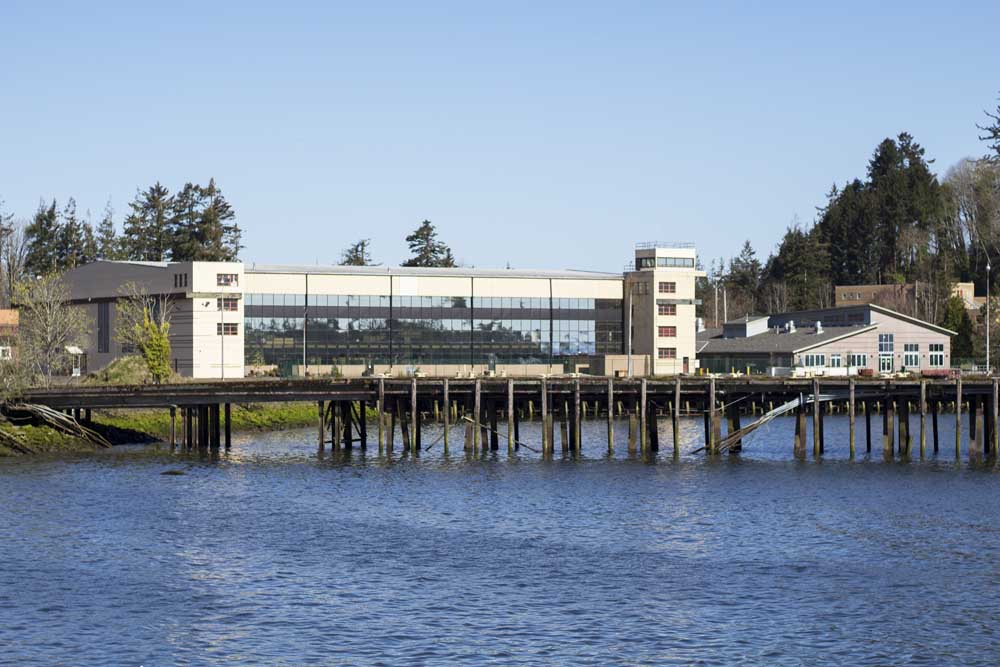First world flight: Northwesterners had the right stuff
Published 11:19 am Thursday, September 26, 2024

- Lt. Lowell Smith was the first of three pilots to land at Seattle’s Sand Point on Sept. 28, 1924, marking the successful end to the first round-the-world flight.
The Wright brothers, Charles Lindbergh, Amelia Earhart, Chuck Yeager — the big names of 20th-century aviation in America have all taken their rightful places in the history of flight.
But in September, a lesser-known aviation feat will mark its 100th anniversary: the first flight to circumnavigate the globe, from Seattle and back in 1924.
The flight came during a Golden Age for aviation.
In the 1920s, thrilling crowds and setting records was the name of the game, as barnstormers and daring pilots competed to make the highest, fastest and longest flights.
In 1924, two men and two mechanics were the first to circle the Earth by airplane — with many stops included — and cities and towns in the Pacific Northwest were front-row spectators.
By 1923, just 20 years after the Wright brothers’ first flight, countries around the world were making plans for the ultimate long-distance mark — an aerial circumnavigation of the Earth.
Similar to the space race of the 1960s, honors and prestige would go to the first country to produce the pilot and plane that could circle the planet by air.
Taking off
Seattle would serve as the starting and finishing point for the flight, while thousands of people in Oregon’s Lane County got a close look at the two airplanes that would eventually accomplish the feat.
And not just one look — the first trip around the world would include two stops in Eugene.
In 1923 and early 1924, four U.S. Army airplanes were designed for the world flight attempt. Known as Douglas World Cruisers, the planes were built by the Douglas Aircraft Co. at Clover Field in Santa Monica, California. The open-cockpit biplanes, with 50-foot wingspans, were made of Sitka spruce lumber from Pacific Northwest forests.
Once initial flight testing was done, three of the four planes departed Clover Field on March 17, 1924, and headed north to Seattle.
The planes flew from Santa Monica to Mather Field in Sacramento, then on to Eugene. The fourth did not get started until March 19, and flew directly from Santa Monica to Eugene.
There was no Mahlon Sweet Field airport in 1924. From the 1920s until its closure in 1955, Eugene’s main landing strip — known as the Eugene Airpark and later as the city’s Municipal Airport — was situated between Chambers and Polk streets, between 13th and 24th avenues. The field included two unpaved landing strips.
From Eugene, the four planes flew north to the Vancouver Barracks, now Pearson Field. The fliers spent the night in Portland, then left in heavy fog the next day and touched down at Seattle’s Sand Point, on the shores of Lake Washington.
Once there, the airplanes — each carrying one pilot and one mechanic — switched from wheels to pontoons for landing gear and were christened with names representing four U.S. cities.
World cruiser No. 1, flown by flight commander Maj. Gen. Frederick Martin with mechanic Alva Harvey, was named the Seattle; plane No. 2, with pilot Lt. Lowell Smith and mechanic Leslie Arnold, became the Chicago; Maj. Gen. Leigh Wade and mechanic Henry Ogden would fly plane No. 3, the Boston; and the fourth plane, with pilot Lt. Erik Nelson and mechanic Jack Harding, was the New Orleans.
The pilots began their round-the-world journey on April 6, taking off from Lake Washington and heading north.
Dropping out
Circling the globe from east to west and against prevailing winds, the American fliers were not the only aviators attempting the first world flight.
Pilots from Argentina, Great Britain, France, Portugal and Italy were making attempts at nearly the same time in 1924. None of the foreign teams, which were flying in a west-to-east direction, would complete their attempts.
Meanwhile, it took less than a month for the first of the American planes to drop out of the race. Martin fell behind because of poor weather conditions and crashed on April 30 into a fog-covered mountain along the Alaska Peninsula.
Both crew members survived the crash with minor injuries, but it took the two men 10 days to make their way out of the mountainous region. They made it back, but with their plane demolished, the Seattle was out of the flight.
Over the next four months, the remaining three planes all had troubles of their own along the route.
The planes flown by Smith and Nelson had engine problems that resulted in forced landings, but both planes were quickly repaired and continued on.
But when Wade’s plane developed an oil leak over the North Atlantic Ocean, the second American plane made a water landing, then officially dropped out of the flight.
As the Boston was being towed by a U.S. Navy ship to the Faroe Islands, storming waves began to swamp the plane, endangering the pilots and crew of the Navy ship. The Boston was finally cut loose and intentionally sunk, to keep the wreckage out of the shipping lanes.
By the time the remaining crews were back on the North American continent, they were down to two planes, the Chicago and the New Orleans. Smith and Nelson were also joined again by Wade in the Boston II, a fifth world cruiser that had been built earlier.
Back on wheels instead of pontoons, the three planes made their way across the U.S., making stops in Boston, Washington, D.C., Chicago and Dallas, among other cities, where thousands greeted and treated the pilots as heroes, although they still had hundreds of miles to go.
On their return to Santa Monica, a reported 200,000 people met the flyers at Clover Field, and the planes once again made the familiar trip up the west coast for the home stretch of the flight.
Reaching destinations
Exactly two months after the close of the 1924 Summer Olympics in Paris, France, the top headline in the Sept. 27, 1924, issue of the Register-Guard blared “Fliers Reach Eugene.”
The American pilots and their mechanics landed in the city for the second time, “to be greeted by the largest crowd ever assembled in the city for any event.”
In the 1925 book “The First World Flight,” author Lowell Thomas wrote, “Eugene is a second home for Smith. He had made his headquarters there during the years when he commanded the forest fire squadron that patrolled the skies over Oregon and Washington.”
And Smith was the center of attention, rekindling old friendships. In his journal, Smith wrote, “Our next stop was at Eugene — my second home — so you can imagine how much attention my friends paid to our requests that they cut the glad-hand business to the minimum. Gov. (Walter) Pierce came from Salem to welcome us on behalf of the people of Oregon, and Mayor (Edwin) Parks, Earl Simmons, Eugene’s aviation enthusiast, and thousands of others from all over that part of the state were there.”
And Eugene would certainly return the favor after the flight was completed, naming an apartment complex and theater after Smith.
The Sept. 29, 1924 issue of the Register-Guard stated, “Citizens of Eugene, state officials of Oregon and representatives of the army air service gathered at the Osburn hotel Saturday night to honor the world fliers.
“The distinguished guests sat at a table in the center of the dining room, with Earl Simmons, toastmaster, Lowell Smith and the five other fliers, Adjutant-General George A. White and Mayer E.B. Parks. Speeches, for the most part, were short.”
The three planes reached Seattle on Sept. 28, with Smith landing first at Sand Point at 1:28 p.m. The official distance over the entire flight was 26,345 miles, with an actual flying time of 363 hours and seven minutes.
On display
After the official flight was over, the fliers spent another two days in Eugene, when the pilots and mechanics were ordered to fly the planes back across the country to McCook Field in Dayton, Ohio, where they were first put on display.
A 15-foot-high monument to the fliers stands on the site of the former airfield at Sand Point, now Magnuson Park in Seattle.
Locally, Dale Roxberg, director and curator of the Oregon Air & Space Museum in Eugene, said the museum has a display set up with information on the flight.
The wreckage that remained of the Seattle can be seen today in the Alaska Aviation Museum in Anchorage, Alaska. The Chicago ended up at the National Air and Space Museum in Washington, D.C.
Meanwhile, the New Orleans is stored, but not on display, at the Natural History Museum in Los Angeles. Talks are underway to bring the plane to the Museum of Flying in Santa Monica for the first world flight’s 100th anniversary.
It’s a first that sometimes gets lost in the shuffle of famous flights.
Three years later, in 1927, Lindbergh flew solo over the Atlantic Ocean and was celebrated in parades across the U.S., including a flyover of Eugene by the Spirit of St. Louis. Earhart grabbed headlines in the 1930s and even more after her disappearance on her attempted world flight in 1937.
The first nonstop round-the-world flight was accomplished in 1949, by a Boeing B-50A Superfortress that took off from Fort Worth, Texas, on Feb. 26, and landed back on March 2.
But in 1924, two men and two mechanics were the first to circle the Earth by airplane — with many stops included — and cities and towns in the Pacific Northwest were front-row spectators.





